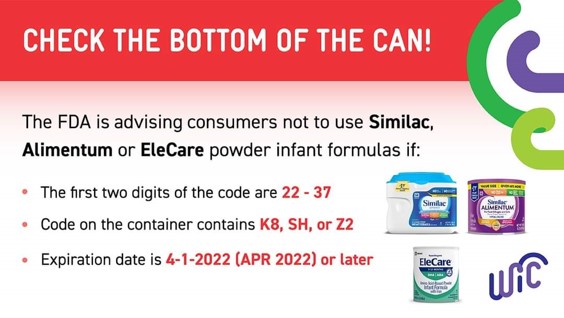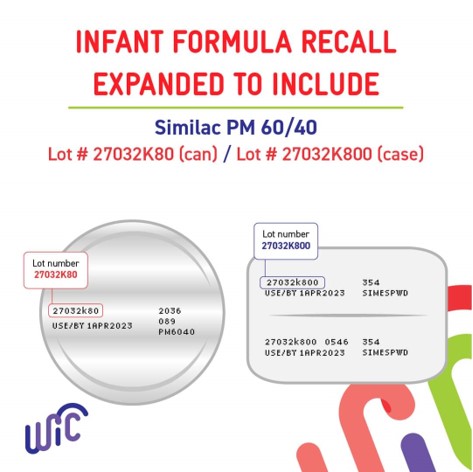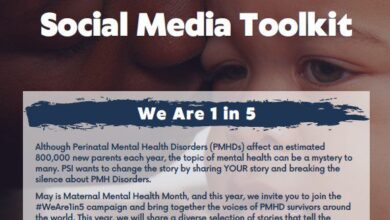Infant Formula Recalls and Proper Powder Formula Preparation

The tragic news of several hospitalizations and infant deaths prompted dire warnings from the FDA and a massive recall by Abbott Nutrition.
The first recall was announced on February 17, 2022, by Abbott Nutrition, which makes the Similac Alimentum and EleCare brands. An additional batch of formula was recalled on February 28, 2022, after another child died of a Cronobacter sakazakii infection in which Similac PM 60/40 formula may have caused the death.
Illnesses and deaths are possibly linked to tainted powdered infant formula manufactured in Michigan and shipped nationally and internationally. Parents should check their Similac brand formulas for lot numbers that may be affected. Babies should not consume recalled formulas.
Consumers are advised not to use Similac, Alimentum or EleCare powdered infant formula if:
- The first two digits of the code are 22 to 37
- The code on the container is K8, SH or Z2
- Expiration date is 4-1-2022 (APR 2022) or later
Consumers using Similac PM 60/40 should avoid products with lot code 2732K800.




Buyers can check their lot number online or call customer service at 1-800-986-8540.
Cronobacter germs can cause blood infections and make the linings surrounding the brain and spinal cord swell. Seek immediate medical attention if an infant has been fed the recalled formula and shows symptoms of Cronobacter infection, which include: fever, poor feeding, crying and low energy.
“Because this is a product that is used as the sole source of nutrition for many of our nation’s newborns and infants, the FDA is very concerned about these reports of bacterial infections. We would like to assure the public that we are diligently working with our partners to investigate complaints related to these products, which we identify as including infant formula manufactured at this facility, as we work to resolve this concern to safety as soon as possible.”
Frank Yiannas, FDA Deputy Commissioner for Food Policy and Response
Although these recalls were issued by Abbott Nutrition, it must be remembered that no powder infant formula is sterile and any powder can be contaminated with Cronobacter sakazakii or Salmonella Newport. To protect fragile newborns from life-threatening bacteria, consumers should follow CDC and WHO recommendations for proper formula preparation.
National and international recommendations for mixing formula differ slightly, and product labels contain too many instructions, adding to the confusion about formula preparation. There are some basic steps that all parents should take to mitigate potential health issues associated with formula preparation. For all powder formulas:
- Check the formula that may be stamped to make sure it’s not part of the recall, and that it hasn’t expired (once a can of powder formula is opened, it’s good for 30 days).
- Practice good hygiene habits (wash hands for at least 20 seconds, clean and sterilize countertops where formula will be prepared, clean top of formula can before opening, sterilize bottles and nipples).
- Heat clean water to 158˚F/70˚C. Be aware that homes built in the US before 1986 often use lead in the pipes. Boiling water containing led concentrates lead levels. Any amount of lead is dangerous. If tap water at home is unsafe, bottled water should be used. Parents without a thermometer, can boil water (water boils at 212˚F) and then let it cool for no more than 30 minutes. This process will ensure that the water is hot enough to kill the bacteria in the powder.
- Pour hot water into a clean bottle.
- Add the powder formula immediately. Follow the manufacturers’ directions regarding loose or packaged powder scoops. For level scoops, use a clean straight edge to ensure correct measurements. Do not try to use ½ a scoop.
- Once the formula is mixed, refrigerate it quickly for feeding. The prepared formula can be immersed in cold water to be placed under cold, running water.
- Prepared unrefrigerated formula should be used within 2 hours. Once feeding begins, the bottle should be discarded after one hour. The formula prepared, can be refrigerated for up to 24 hours. It’s more convenient for formula-feeding families to make several bottles at once and refrigerate them. They can be reheated before feeding.
These steps should be used to prepare any powder formula. It is especially important to follow these steps for any baby under 3 months old, one born prematurely or with a weakened immune system.
Parents who use ready-made formula, only need to sterilize the nipple they connect to the ready-made bottles. If the prepared formula is transferred to a bottle, the bottle and nipple must be sterilized. Liquid formula is easier to use, but often costs more and may not be available.
Parents should educate themselves about donor human milk and informal milk sharing. In an emergency situation and with formula shortages, these resources can be lifesaving.
About the Author


Christy Jo Hendricks, IBCLC, RLC, CLE, CCCE, CCD brings more than 20 years of teaching experience to the classroom. She is an Internationally Board-Certified Lactation Consultant (IBCLC) and Certified Birth Doula. She has a passion for facilitating and protecting the mother/baby bond. Her contribution in this field has been recognized by the United States Presidential Volunteer Award and the Phyllis Klaus Founder’s Award for Promoting the Mother/Baby Bond. Christy Jo’s lifelong goal is to help others reach their goals. His informative, yet entertaining teaching style makes learning enjoyable and retention easy.





